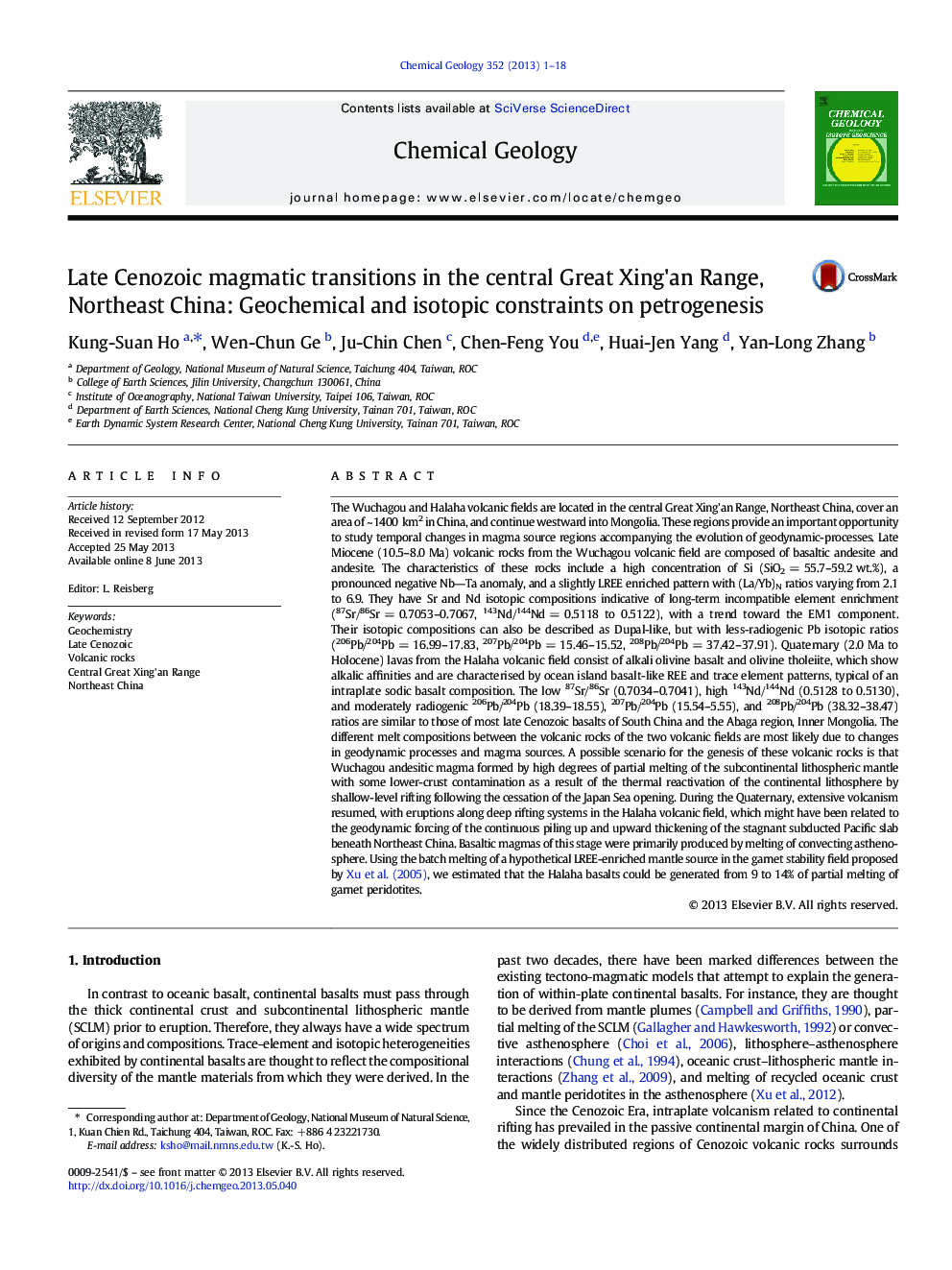| کد مقاله | کد نشریه | سال انتشار | مقاله انگلیسی | نسخه تمام متن |
|---|---|---|---|---|
| 4698962 | 1637617 | 2013 | 18 صفحه PDF | دانلود رایگان |

• Investigated the variation of magma sources during two eruptive events
• Andesitic magma probably formed by PM of the SCLM with lower-crust contamination.
• Basaltic magma originated from a garnet peridotite source at the asthenosphere.
• Two eruptive events were related to the Japan Sea opening & asthenospheric upwelling.
The Wuchagou and Halaha volcanic fields are located in the central Great Xing'an Range, Northeast China, cover an area of ~ 1400 km2 in China, and continue westward into Mongolia. These regions provide an important opportunity to study temporal changes in magma source regions accompanying the evolution of geodynamic-processes. Late Miocene (10.5–8.0 Ma) volcanic rocks from the Wuchagou volcanic field are composed of basaltic andesite and andesite. The characteristics of these rocks include a high concentration of Si (SiO2 = 55.7–59.2 wt.%), a pronounced negative Nb―Ta anomaly, and a slightly LREE enriched pattern with (La/Yb)N ratios varying from 2.1 to 6.9. They have Sr and Nd isotopic compositions indicative of long-term incompatible element enrichment (87Sr/86Sr = 0.7053–0.7067, 143Nd/144Nd = 0.5118 to 0.5122), with a trend toward the EM1 component. Their isotopic compositions can also be described as Dupal-like, but with less-radiogenic Pb isotopic ratios (206Pb/204Pb = 16.99–17.83, 207Pb/204Pb = 15.46–15.52, 208Pb/204Pb = 37.42–37.91). Quaternary (2.0 Ma to Holocene) lavas from the Halaha volcanic field consist of alkali olivine basalt and olivine tholeiite, which show alkalic affinities and are characterised by ocean island basalt-like REE and trace element patterns, typical of an intraplate sodic basalt composition. The low 87Sr/86Sr (0.7034–0.7041), high 143Nd/144Nd (0.5128 to 0.5130), and moderately radiogenic 206Pb/204Pb (18.39–18.55), 207Pb/204Pb (15.54–5.55), and 208Pb/204Pb (38.32–38.47) ratios are similar to those of most late Cenozoic basalts of South China and the Abaga region, Inner Mongolia. The different melt compositions between the volcanic rocks of the two volcanic fields are most likely due to changes in geodynamic processes and magma sources. A possible scenario for the genesis of these volcanic rocks is that Wuchagou andesitic magma formed by high degrees of partial melting of the subcontinental lithospheric mantle with some lower-crust contamination as a result of the thermal reactivation of the continental lithosphere by shallow-level rifting following the cessation of the Japan Sea opening. During the Quaternary, extensive volcanism resumed, with eruptions along deep rifting systems in the Halaha volcanic field, which might have been related to the geodynamic forcing of the continuous piling up and upward thickening of the stagnant subducted Pacific slab beneath Northeast China. Basaltic magmas of this stage were primarily produced by melting of convecting asthenosphere. Using the batch melting of a hypothetical LREE-enriched mantle source in the garnet stability field proposed by Xu et al. (2005), we estimated that the Halaha basalts could be generated from 9 to 14% of partial melting of garnet peridotites.
Journal: Chemical Geology - Volume 352, 16 August 2013, Pages 1–18